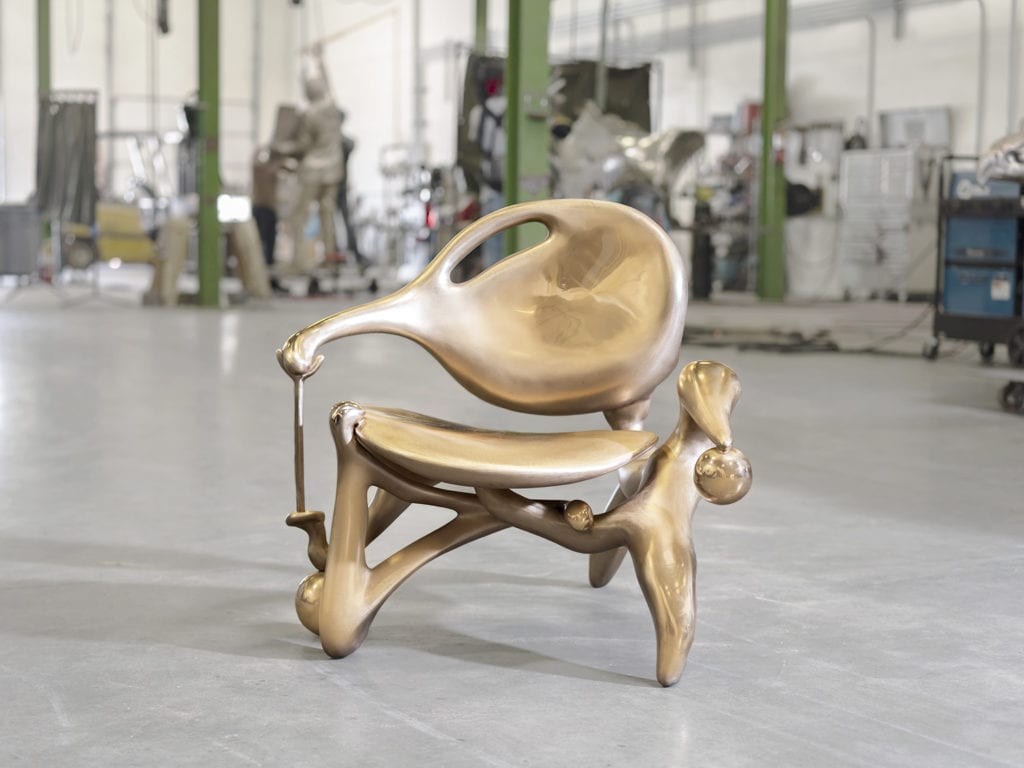
Alien Furnishing and Hometown Romance w/ Misha Kahn November 13, 2022

Misha Kahn may have been born in Duluth, but his work is something from another planet. Kahn’s furniture is often described as extraterrestrial, combining dramatic futuristic looks with practical function. In a sculptural art form described as “assemblage,” Kahn is notorious for finding creative ways to use unorthodox sculpting materials from pool noodles to temperamental heavy metals. We recently caught up with the Brooklyn transplant who was gracious enough to give us a little glimpse into what makes him tick.
BLNCD: Misha! How are you? How have you been surviving the past year? What keeps you grounded?
MK: I don’t know if anything has kept me grounded! I’ve been running almost every day – I think that’s the only thing that has kept me feeling somewhat sane. I’ve been sleeping an insane amount – I plan on waking up on the other side of all this.
BLNCD: Your work exists at a unique crossroads of art museum sculpture and the practicality of everyday furniture. When you’re making these incredible art pieces that are also tables, do you imagine them in people’s homes with a starbucks cup resting on top? How do you negotiate the space between your wild imagination and the functionality of the furniture?
MK: I imagine the world I’m furnishing so fully that the starbucks cup starts to feel like the object so outlandish, it’s hard to wrap your head around – that some multinational chain would succeed by serving hot bean water in cups made of ground up trees with lids that are fabricated of eons of decomposed carcasses and plant life, and that when you analyze their business plan in fact they’re not really selling hot bean water, they’re peddeling another species’ teat lactations.



BLNCD: What’s the biggest difference in the way you approach your work now, versus five years ago?
MK: I’m able to be a lot more focused. I used to try to finish pieces really quickly – which gave them a kind of sketch-like quality that I valued. Now I’m working on really big projects that take years to see finished – and I feel relatively calm about that.
BLNCD: Your career has reached a level of sustainability that a lot of young artists dream of. What do you think has been the most instrumental person, event, or personal ideology that has helped you get to where you are?
MK: There’s that part of the Paris Hilton documentary where she talks about earning ten million or something, her goal, and then deciding she needed to make 1 billion to feel “financially secure.” In my squalid way, I think my daily sense that I haven’t achieved what I’m trying to do, and perpetually moving that goal post has pushed me along. So, my answer is personal mental torment.
BLNCD: Describe the environment where you are the most productive. Time of day? Music? Snacks?
MK: All of those things! I think late afternoon after my second or third giant coffee and my daily massive cookie, I’m in the studio and someone else is DJ-ing. The light in my studio is really wild late in the day – it sets over the east river and floods in through the field of electrical transformers.
BLNCD: Having grown up in Duluth, do you feel your Minnesota roots have impacted your work or process in any way?
MK: In lots of ways. I mean, in general I think there’s a kind of grit and work ethic to the midwest that at least I know to feel guilty about not having on my lazy days. There’s also tidbits of both Minnesota nostalgia, romance, and reality that have been aesthetic influences. On the romantic side, the ways that things get put together can be a bit MacGyver-ey and log cabin-esque, and that northwoods palette that goes with that. Sometimes I’ll think about the aesthetic qualities of, say, a neon detailed polaris snowmobile situation near a house with faux wood vinyl siding – the juxtaposition of nature with the bright colors, the relationship of artificial and reality is all very interesting as well.

BLNCD: As an artist, is there something that still feels uncharted for you? A new medium or creative challenge you’re hoping to take on in the next few years?
MK: Yes, I want to sprawl… I’m hoping to do more public art, getting to work on really large scale pieces.
BLNCD: If you had to pick three raw materials that are most essential to your work, what would they be?
MK: I don’t think I can pick just three, so I’ll say pencil, wine, and snacks.
Story by John Mark